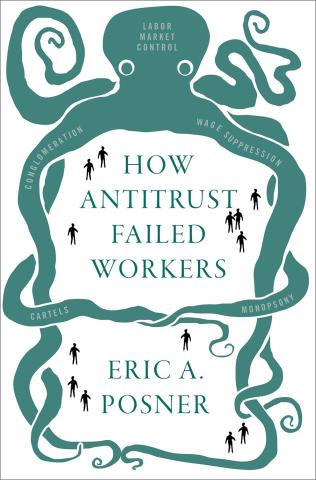How Antitrust Failed the American Worker
The same laws that protect consumers from monopoly power could be used to boost wages and improve working conditions, Professor Eric Posner argues in a new book.
When we think of antitrust law, we think consumer protection: high-profile litigation that prevents monopolies from restricting the public’s personal computing choices or overcharging them for long-distance phone service.
But antitrust law can—and should—protect workers, too, Professor Eric A. Posner argues in a new book, How Antitrust Failed Workers (Oxford University Press, 2021).
Instead, highly concentrated markets in which employers wield excessive power over wages and working conditions are remarkably common—and the failure to rein them in may be costing millions of Americans thousands of dollars, or even tens of thousands of dollars, in pay. According to one estimate, concentrated labor market power reduces overall output and employment by 13 percent, writes Posner, the Kirkland and Ellis Distinguished Service Professor of Law.
“Antitrust law should police labor markets just as it polices product markets,” he writes, adding that wage-fixing may hurt the economy as much as price-fixing—and cause disproportionate harm to lower-income Americans.
Antitrust laws like the Sherman and Clayton acts are viable tools: the law doesn’t distinguish between monopoly (when a firm is the sole producer) and monopsony (when a firm is the sole purchaser, or in the case of a labor monopsony, the sole employer), Posner writes.
Monopolies, however, receive almost all the attention.
“Many courts have … acknowledged that workers, in theory, can bring an antitrust claim against employers who form labor market cartels,” Posner told a US House of Representatives subcommittee during a hearing on antitrust and labor markets on September 28. “Yet, while thousands of antitrust cases have been brought over the years, hardly any have addressed labor market cartelization. The Justice Department and the Federal Trade Commission have reviewed thousands of mergers, approving some and rejecting others, but have not even once analyzed the labor market effects of a merger. The famous blockbuster monopoly cases—like Standard Oil, AT&T, and Microsoft—are not matched by famous, or any, monopsony cases.”
There are a variety of possible reasons for the gap, Posner says. It could be the focus on consumer welfare by antitrust scholars, the reliance on labor law as the primary vehicle for worker protection, or the fact that it is easier to bring a class action against a seller than against an employer. It could also be that, until recently, economists assumed that labor markets were sufficiently competitive.
A rise in labor-market-dampening practices has shown that not to be the case. Noncompete agreements, which prevent workers from moving to a competitor, and no-poaching agreements, in which employers agree not to recruit each other’s employees, have reduced job mobility, often for lower-wage workers. In one case, the sandwich franchise Jimmy John’s required workers to sign noncompetes that prevented them from working for another sandwich shop within three miles of any Jimmy John’s shop for two years—an onerous restriction given the thousands of Jimmy John’s franchises that exist in the United States. The agreements were likely illegal and unenforceable, Posner writes, but they also likely kept low-income workers from seeking higher paying jobs. The company eventually withdrew the noncompete agreements when it settled litigation brought by state attorneys general.
Posner also raises concerns about more conventional types of wage-fixing—competing companies exchanging wage information through organizations—as well as the impact of mergers, which concentrate labor markets and have been shown to lead to wage declines.
He argues for a variety of reforms—clear guidance for workers seeking remedies for anticompetitive behavior; crackdowns on labor market manipulation; steps by federal agencies to review the market effects of mergers; and more.
But his primary argument is that existing antitrust law remains an untapped resource.
“[T]he historic neglect of labor monopsony by antitrust law is not justified by theory, law, or the nature of labor markets,” he writes. “[A]ntitrust law as it is understood today has been underused in labor markets…good lawyers and sophisticated regulators and judges who are attentive to the special features of labor markets could make progress even without legal reform.”
